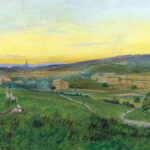22 May 1711: Leeds’s first white-cloth hall is opened on Kirkgate, replacing the outdoor market on Briggate, and competing with Wakefield’s 1710 building
Ralph Thoresby. 1715. Ducatus Leodiensis. London: Maurice Atkins. Get it:
.Unedited excerpt
The excerpt in the book is shorter, edited and, where applicable, translated.
PAGE 38, was mentioned an old ruinous Hospital of an uncertain Tenure and Foundation, since which Time, by the Favour of the Lord of the Manor, the Title is cleared, and the Poor being otherwise provided for, ’till a more convenient Habitation be builded for them (which will e’er long be performed) the Cottages are taken down, and a stately Hall for White Cloths erected at near a Thousand Pounds Charge by certain Merchants and Tradesmen in Town; ’tis built upon Pillars and Arches in the Form of an Exchange, with a Quadrangular Court within: Both the higher and lower Stories are replenished with that Sort of Goods; which ’till this Juncture, the Makers had to carry Samples of to each of the Merchants Houses they dealt with; and these had the Trouble, upon emergent Occasions, to ride to the several Townships or Hamlets of Heaton, Berkenshaw, and Bradford-dale, Alverthorp, Birstall, Little-town, Heckmondwike, Batley and Duesbury, Great and Little Gomersall, Robert-town, Mirfield, Clifton, and Hathet, as they are enumerated upon the Doors of the distinct Repositories, where the Goods are lodged ’till the weekly Markets upon Tuesdays Afternoon, of which Notice is given by the Bell in a beautiful Cupulo painted and gilt.
Comment
Comment
Hathet?
By the early 18th century, cloth trading had outstripped the capacity of the bridge, and had moved to trestle tables in up to two rows on each side of Briggate. Ralph Thoresby was involved in the establishment of the first covered cloth market, when with others he secured the permission of the 3rd Viscount Irwin, holder of the Manor of Leeds, to erect the White Cloth Hall. The fact of Wakefield having erected a trading hall in 1710 was almost certainly a driver of change. The new hall opened on 22 May 1711. It lasted for 65 years before being removed to a new site in The Calls; by the mid-19th century it was taking place in a dedicated trading hall.
Thoresby gives the date in his diary (Thoresby 1830).
Something to say? Get in touch
Similar
 30 May 1835: Alfred Austin, future poet laureate, “Banjo-Byron that twangs the strum-strum,” is born into rural splendour at Ashwood, 48 Headingley Lane, Leeds
30 May 1835: Alfred Austin, future poet laureate, “Banjo-Byron that twangs the strum-strum,” is born into rural splendour at Ashwood, 48 Headingley Lane, Leeds
Comment
Comment
Baines meets with Willans and Dickinson on the 13th https://link.gale.com/apps/doc/Y3201483804/BNCN?u=leedscl&sid=bookmark-BNCN&xid=e7deebdc
source summarises https://books.google.co.uk/books?id=nnkwAQAAMAAJ&vq=june%2013&pg=PA261#v=snippet&q=june%2013th&f=false
The Stump Cross Inn in Morley is still serving – perhaps they’d like to consider a special offer on rum and milk on 6 June?
Byng became General Officer Commanding the Eastern District in England in October 1815 before transferring to be General Officer Commanding the Northern District in England in June 1816. At the Peterloo Massacre of 1819, he was absent because he had two horses entered at York races that day, and delegated command to his deputy, who failed to peacefully disperse the large crowd, resulting in 18 deaths and hundreds of injuries.
Something to say? Get in touch
Search
Donate
Music & books
Place-People-Play: Childcare (and the Kazookestra) on the Headingley/Weetwood borders next to Meanwood Park.
Music from and about Yorkshire by Leeds's Singing Organ-Grinder.


 Bluesky
Bluesky Extwitter
Extwitter